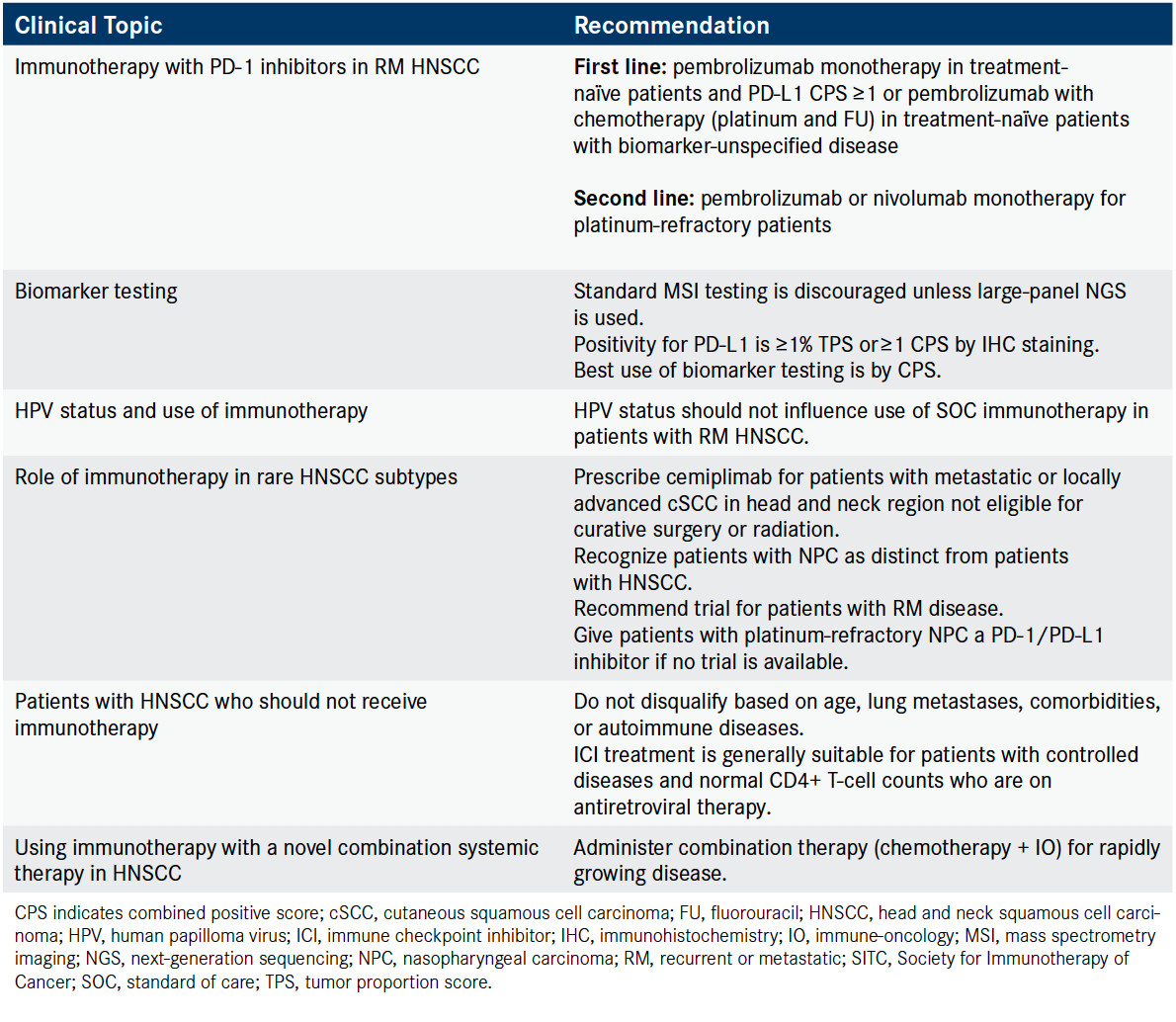SITC Introduces Guidelines for Anti–PD-1 Therapy in HNSCC
Based on strong findings for efficacy and safety, as well as FDA approvals, the Society for Immunotherapy of Cancer has issued the first guidelines for the use of immunotherapy agents in patients with recurrent or metastatic head and neck squamous cell carcinoma.
Malini Patel, MD

Malini Patel, MD
Based on strong findings for efficacy and safety, as well as FDA approvals, the Society for Immunotherapy of Cancer (SITC) has issued the first guidelines for the use of immunotherapy agents in patients with recurrent or metastatic (RM) head and neck squamous cell carcinoma (HNSCC).
Approvals of checkpoint inhibitors in this setting began in 2016, when nivolumab (Opdivo) and pembrolizumab (Keytruda) were approved for HNSCC that is refractory to platinum- based regimens. This was followed in 2019 by the approval of pembrolizumab in combination with platinum and fluorouracil as a first-line treatment for all patients with metastatic or unresectable, recurrent HNSCC and for pembrolizumab as a monotherapy for HNSCC tumors that express a PD-L1 combined positive score (CPS) of ≥1.
The recommendations are aimed at practicing oncologists, SITC officials said. “The guidelines will inform clinicians on how to strategically and safely administer these treatments for their patients,” Mario Sznol, MD, SITC president, said in a statement.
In clinical practice, immunotherapies have been rapidly adopted by physicians treating patients with HNSCC, said Malini Patel, MD, one of the many clinicians who will be using the guidelines.
“The single-therapy approvals of pembrolizumab and nivolumab were exciting for head and neck medical oncologists, because time after time when we went to national and international meetings, we would see negative trials [of other agents],” said Patel, a thoracic oncologist at Rutgers Cancer Institute of New Jersey in New Brunswick. “There hadn’t been an approved agent in well over a decade for metastatic head and neck cancer.”
The SITC guidelines address trial findings that support the use of these drugs, appropriate patient selection, therapy sequence, response monitoring, adverse event management, and biomarker testing (Table).1
“Similar to what we’re seeing in other solid tumor groups, the incorporation of immunotherapy has now become commonplace in head and neck cancer and at a rapid pace,” Patel said. “There needs to be a set of guidelines to help community and academic physicians treat patients as we use immunotherapy in the first line and address disease progression.”
Surgical resection of the primary tumor and lymph node draining, followed by adjuvant radiation, with or without platinum- based chemotherapy, or primary definitive concurrent chemoradiation remain the principal treatments for locally advanced HNSCC.1
Category 1 Evidence for Anti—PD-1
The SITC guideline-drafting subcommittee noted that category 1 evidence exists for using single-agent anti—PD-1 immunotherapy in patients with RM HNSCC whose disease progressed after platinum-based chemotherapy or who have not received prior treatment with platinum-based chemotherapy. These data principally derive from KEYNOTE-040, KEYNOTE-012, CheckMate 141, and KEYNOTE-048.
Table. SITC’s Immunotherapy Recommendations for RM HNSCC: Key Highlights1 (Click to Enlarge)

Moreover, 18% and 21% of patients achieved an overall response by central review and investigator assessment, respectively. Investigators said KEYNOTE-012 was the first study to demonstrate the effectiveness of immunotherapy for RM HNSCC.
The phase III CheckMate-141 trial (NCT02105636) precipitated the approval of nivolumab. Investigators enrolled 361 patients with recurrent HNSCC whose disease had progressed within 6 months after platinum-based chemotherapy and randomized them 2:1 to receive nivolumab every 2 weeks or standard, single-agent systemic therapy (methotrexate, docetaxel, or cetuximab [Erbitux]).3
Median OS was superior with nivolumab at 7.5 months (95% CI, 5.5-9.1) versus 5.1 months (95% CI, 4.0-6.0) with standard therapy. OS was also longer with nivolumab than with standard therapy (HR, 0.70; 97.73% CI, 0.51-0.96; P = .01).
The phase III KEYNOTE-048 trial (NCT02358031), which led to the FDA’s 2019 approvals of pembrolizumab plus chemotherapy as a frontline combination and pembrolizumab as a single agent, evaluated the efficacy of pembrolizumab alone and in combination in 882 treatment-naïve patients with locally incurable RM HNSCC.4
Pembrolizumab plus chemotherapy versus cetuximab plus chemotherapy significantly improved median OS in the CPS ≥20 population (14.7 vs 11.0 months; HR, 0.60; P = .0004) and in the CPS ≥1 population (13.6 vs 10.4 months; HR, 0.65; P <.0001).
Biomarker Testing
The FDA did not require biomarker testing for use of nivolumab and pembrolizumab in patients with RM HNSCC who have progressed on or after platinum therapy. However, most patients will progress on these agents; therefore, patient selection tools are critical, the SITC guidelines note. PD-1 expression, tumor mutational burden, and immune gene signatures have been evaluated as biomarkers in HNSCC.
KEYNOTE-048 provided level 1 evidence for the use of PD-L1 expression analysis, according to the subcommittee. The approval of pembrolizumab for tumors that express PD-L1 CPS ≥1 was the first mandated biomarker testing for patients with RM HNSCC tumors. SITC said unresectable or metastatic microsatellite instability (MSI)—high HNSCC tumors are relatively infrequent (1%-3%), which led the subcommittee (88%) to not recommend routine MSI testing.
Defining when biomarker testing is necessary and in what settings was considered of critical importance in developing the HNSCC guidelines, said Robert L. Ferris, MD, PhD, chair of the SITC Cancer Immunotherapy Guidelines Head and Neck Cancers Subcommittee.
He noted that prior authorization for biomarker testing should be added to the checklist for oncologists working with these drugs. “Testing can get confusing between lung and head cancers and neck and melanoma cancers, so it’s important for that community oncologist who may treat several diseases to remember when they’re going to need to do biomarker testing in order to get payer approval to support the use of these agents,” he said. Ferris was the co-principal investigator and lead author of CheckMate 141.
Monitoring and Evaluation
The SITC guidelines call for vigilant patient monitoring, evaluation, and management when using immunotherapies and note that responses to immunotherapy are vastly different than for cytotoxic chemotherapy: “Patients receiving checkpoint inhibitors may have stable disease for many months before experiencing a radiographic objective response.”1
There is no level 1 evidence supporting the use of Response Evaluation Criteria in Solid Tumors (RECIST) in RM HNSCC, but all studies demonstrating efficacy of anti—PD-1 in HNSCC have used RECIST v1.1, the guidelines noted. They said such monitoring is essential during and after immunotherapy treatment. For patients experiencing a near complete response (CR) or CR following immunotherapy treatment, 53% of the subcommittee recommended continuing treatment for ≥2 years or until progression/toxicity.
The subcommittee unanimously agreed that the use of overall response rate (ORR) and overall survival (OS) to describe study outcomes post checkpoint blockade in patients with HNSCC is sufficient for future therapeutic consideration, and 41% of the subcommittee said they would favor OS over ORR. Further, 88% agreed it is not acceptable to treat patients beyond progression if there is symptomatic progression or clinical deterioration.
Eligibility for Immunotherapy
Most subcommittee members indicated that their decision to recommend immunotherapy would be influenced by the presence of RM disease (89%), previous platinum therapy (78%), and patient performance status (56%).
The subcommittee agreed (81%) that autoimmune disease should not automatically exclude patients from immunotherapy but said that the specific disease should be factored into the decision whether to treat. It agreed that age (89%), lung metastases (89%), and comorbidities (75%) are not reasons for disqualifying treatment with anti—PD-1 therapy. Older patients find immunotherapies more tolerable than cytotoxic therapies, they noted.
The subcommittee also noted the value of multiple-drug regimens for increasing patient response and combating immune resistance. “As no combination strategies are currently approved in the [immunotherapy] refractory disease setting,…the subcommittee (94%) recommends enrolling a patient with RM HNSCC into a clinical trial assessing a combination immunotherapeutic approach,” they wrote.
For locally recurrent disease, which carries no option for surgical or radiation therapy, and for metastatic disease in the first-line setting, the standard of care remains platinum- based doublet chemotherapy with cetuximab. Until recently, second-line treatments were limited to cetuximab, methotrexate, and a taxane before the 2016 and 2019 immunotherapeutic gains. Each agent generates response rates of 10% to 13% and a median progression-free survival of 2 to 3 months. None is associated with a clear improvement in OS.
SITC began writing the HNSCC guidelines in 2018, delaying publication to ensure that the recommendations reflected findings from KEYNOTE-048 and the anticipated pembrolizumab approval. “When the positive data from this trial [were] presented at the 2018 [European Society for Medical Oncology] congress, we knew we’d eventually have not only approvals for the second line but [also] an imminent approval in the first line,” Ferris said.
“We knew the FDA had to issue a decision on pembrolizumab in HNSCC by its action date of June 10, 2019,” Ferris said. “It was all quite well timed.”
HNSCC is the ninth leading cancer by incidence worldwide and constitutes 90% of all head and neck cancers.1 The cancer develops in the squamous mucosal lining of the upper aerodigestive tract, including the lip, oral, and nasal cavities and the paranasal sinuses, nasopharynx, oropharynx, larynx, and hypopharynx, and accounts for more than 10,000 deaths in the United States each year. The majority of diagnoses are for locally advanced disease that carries a high risk of recurrence. In contrast, about 10% of cases are metastatic at diagnosis.
References
- Cohen EEW, Bell RB, Bifulco CB, et al. The Society for Immunotherapy of Cancer consensus statement on immunotherapy for the treatment of squamous cell carcinoma of the head and neck (HNSCC). J Immunother Cancer. 2019;7(1):184. doi: 10.1186/s40425-019-0662-5.
- Seiwert TY, Burtness B, Mehra R, et al. Safety and clinical activity of pembrolizumab for treatment of recurrent or metastatic squamous cell carcinoma of the head and neck (KEYNOTE-012): an open-label, multicentre, phase 1b trial. Lancet Oncol. 2016;17(7):956-965. doi: 10.1016/S1470- 2045(16)30066-3.
- Ferris RL, Blumenschein G, Fayette J, et al. Nivolumab for recurrent squamous-cell carcinoma of the head and neck. N Engl J Med. 2016;375:1856-1867. doi: 10.1056/NEJMoa1602252.
- Rischin D, Harrington KJ, Greil R, et al. Protocol-specified final analysis of the phase 3 KEYNOTE-048 trial of pembrolizumab (pembro) as first-line therapy for recurrent/metastatic head and neck squamous cell carcinoma (R/M HNSCC). J Clin Oncol. 2019;37(suppl 15; abstr 6000). doi: 10.1200/ JCO.2019.37.15_suppl.6000.
Data from the phase Ib KEYNOTE-012 study (NCT01848834) led to the approval of pembrolizumab monotherapy in patients with RM HNSCC after the agent demonstrated tolerability and clinically meaningful antitumor activity.2 Overall survival (OS) was 13 months (95% CI, 5-not reached) and duration of response was approximately 53 weeks (12.2 months).




